How to Crop an Image Online — Easy Step-by-Step Guide
10/27/2025
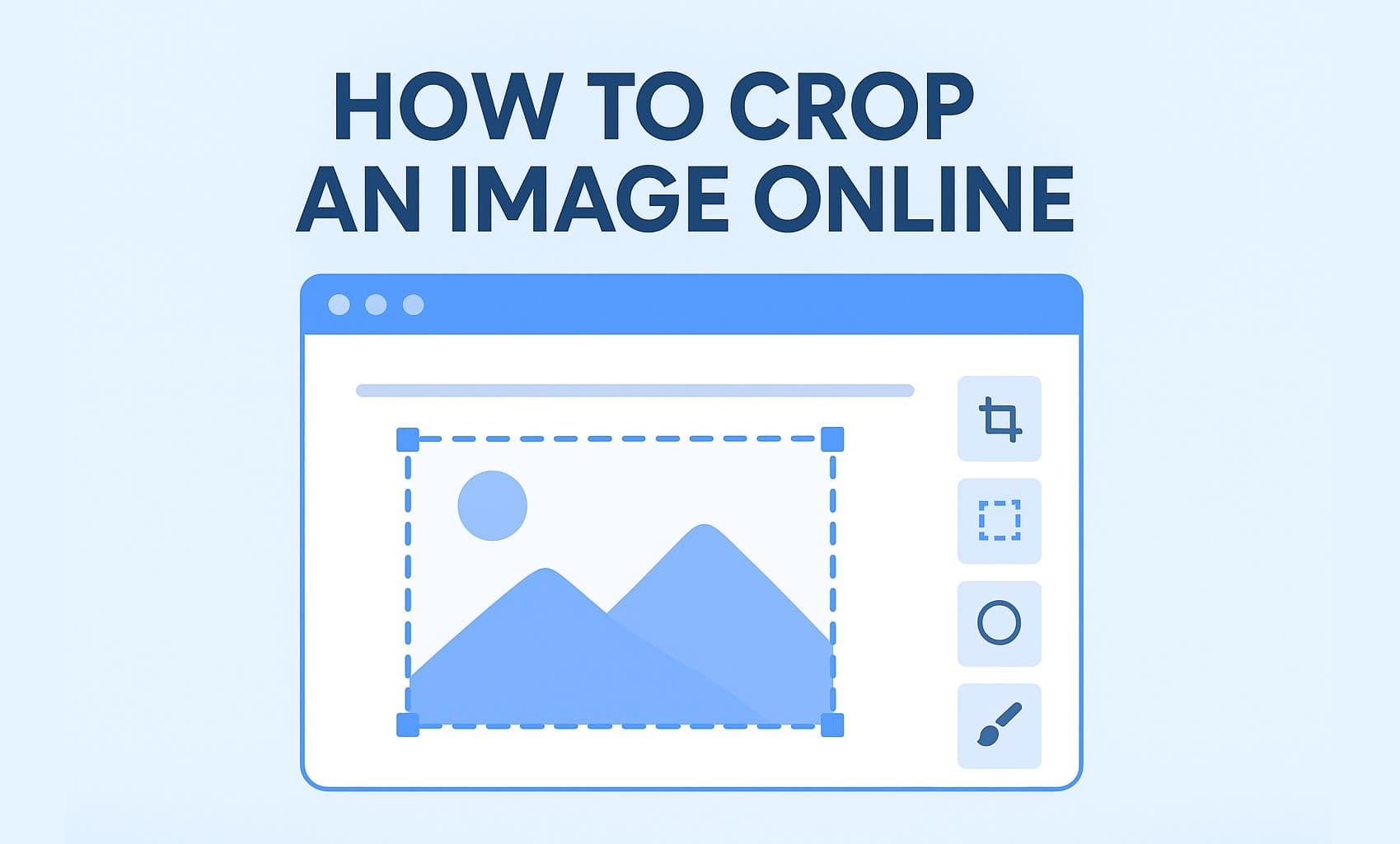
Introduction – Why Cropping Images Matters
Have you ever taken a perfect photo, only to realize there's a random stranger in the background? Or maybe your subject is positioned awkwardly with too much empty space on one side? Perhaps you need to fit an image into a specific size for your website, but it just doesn't look right?
This is where image cropping becomes your best friend.
Cropping is one of the most fundamental yet powerful tools in image editing. It's the digital equivalent of using scissors to cut away the parts you don't want, keeping only what matters. Unlike other complex editing techniques that require artistic skills or technical knowledge, anyone can crop an image effectively — and the results are often transformative.
Whether you're a professional photographer polishing portfolio shots, a social media manager preparing content for Instagram, a blogger optimizing images for your website, or simply someone who wants their personal photos to look better, understanding how to crop images properly is an essential skill in today's visual-first digital world.
The beauty of modern technology is that you don't need expensive software like Photoshop anymore. Free online tools now offer professional-grade cropping capabilities right in your browser, making the process faster and more accessible than ever before.
In this comprehensive guide, we'll walk you through everything you need to know about cropping images. You'll learn what cropping actually means, why it matters, how to do it step-by-step using our free online crop tool, and professional tips that will help you crop like an expert every single time. Whether you need to crop, resize, rotate, or convert your images, we've got you covered.
How to Crop an Image Step by Step (Using ImageToolo)
Let's walk through the complete cropping process. Even if you've never edited an image before, you'll be cropping like a pro by the end of this section.
📤 Step 1: Upload Your Image
Navigate to ImageToolo's Crop Tool in any web browser. The tool works perfectly on desktop computers, laptops, tablets, and smartphones.
Click the Upload Image button or drag and drop your file directly into the designated area. ImageToolo accepts all standard formats: JPG, PNG, WEBP, GIF, and more. Your image uploads securely through an encrypted connection.
Within a second or two, your image appears in the workspace, ready for cropping. The tool automatically analyzes the image dimensions and prepares the cropping interface.
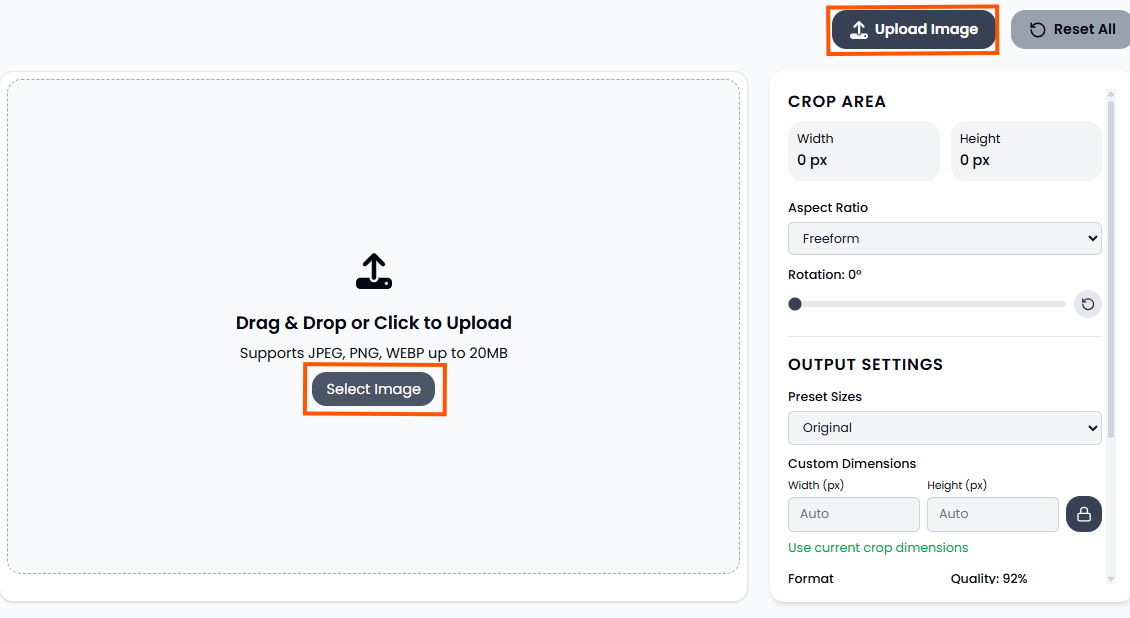
✂️ Step 2: Select Your Crop Area
This is where the magic happens. You'll see your image displayed with a crop overlay — typically a rectangle with handles at the corners and edges.
Free-Form Cropping: Click and drag any corner or edge handle to define your desired crop area. The overlay shows exactly what will remain after cropping, with the areas outside the selection dimmed or darkened. This visual feedback makes it easy to see your final result before committing.
Aspect Ratio Presets: ImageToolo provides quick-select buttons for common aspect ratios:
- 1:1 (Square) — Perfect for Instagram posts and profile pictures
- 4:5 (Portrait) — Ideal for Instagram portraits and vertical content
- 16:9 (Landscape) — Standard for YouTube thumbnails and website banners
- 9:16 (Vertical) — Optimized for Instagram/Facebook Stories
- Custom — Define any dimensions you need
Selecting a preset locks the crop rectangle to that ratio, preventing accidental distortion as you resize it.
Positioning the Crop: Click inside the crop area and drag to reposition it over your image. This lets you frame your subject perfectly without changing the crop size.
Precision Controls: For exact dimensions, enter specific pixel values or percentages. This is particularly useful when you need images to fit precise specifications.
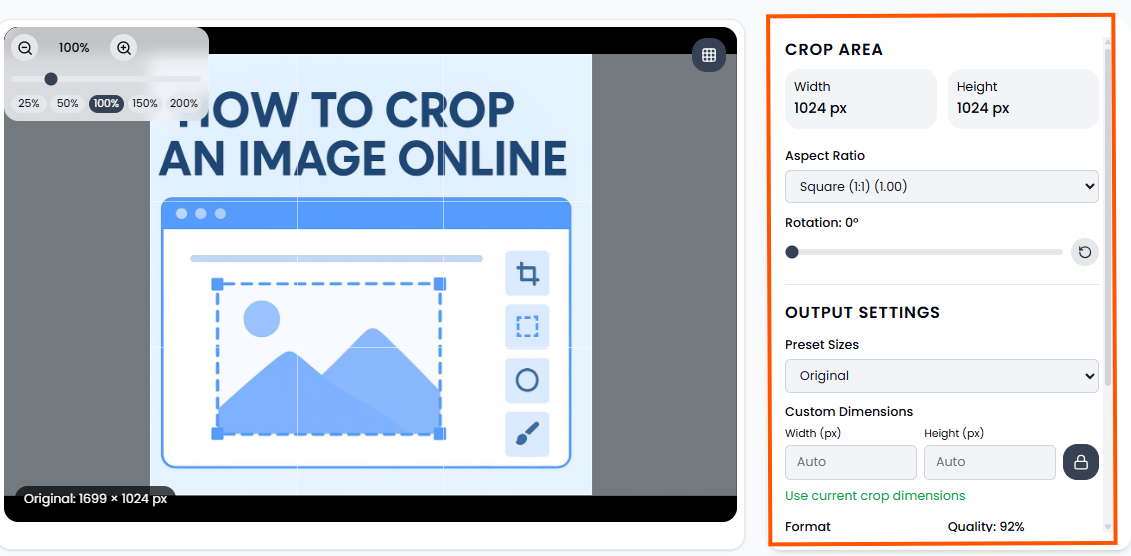
👁️ Step 3: Adjust Size and Preview
Before finalizing your crop, take a moment to refine it:
Zoom In for Details: Use zoom controls to magnify your image and ensure important details aren't accidentally cropped out. This is especially important for portraits where you want to avoid cutting off parts of faces. If you need to adjust canvas size after cropping, try the resize tool.
Grid Overlays: Enable compositional grid overlays (like the rule of thirds grid) to help position subjects at visually pleasing points. These guides help create professional-looking compositions.
Live Preview: The interface shows exactly what your cropped image will look like. What you see is what you get — no surprises after downloading.
Fine-Tune Positioning: Make small adjustments to get everything perfect. Move the crop area by a few pixels, slightly adjust the size, ensure horizons are level within the crop.
Take your time here. The difference between a good crop and a great crop often comes down to these small refinements.
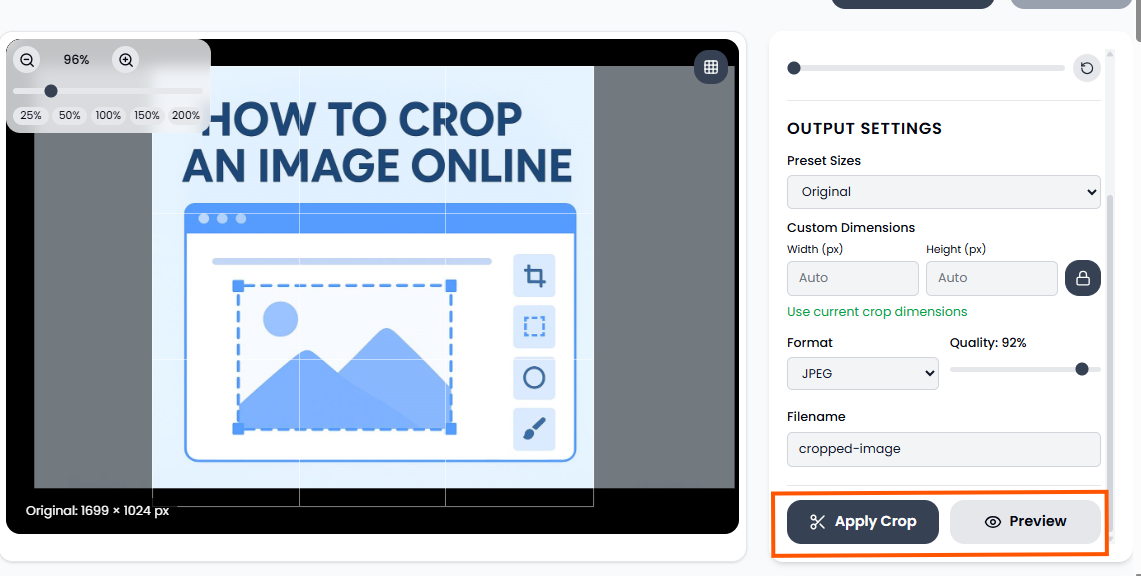
⬇️ Step 4: Download Your Cropped Image
Satisfied with your crop? Time to save it.
Choose Output Format: Select your preferred format. JPG works great for photographs, PNG preserves transparency and is ideal for graphics, WEBP offers the best compression with quality retention. Check our guide on comparing image formats to make the best choice. If you need to convert formats, use our convert tool, and if you want to shrink the final file size, run it through the compress tool - you can learn more about compression in our complete compression guide.
Quality Settings: Adjust quality if you want to compress the file. For most uses, 85-90% quality provides excellent visuals with reasonable file sizes.
Click Download: Your perfectly cropped image downloads immediately. The filename indicates it's been cropped, helping you distinguish it from the original.
ImageToolo automatically deletes your uploaded image from its servers after processing, ensuring your privacy and security.
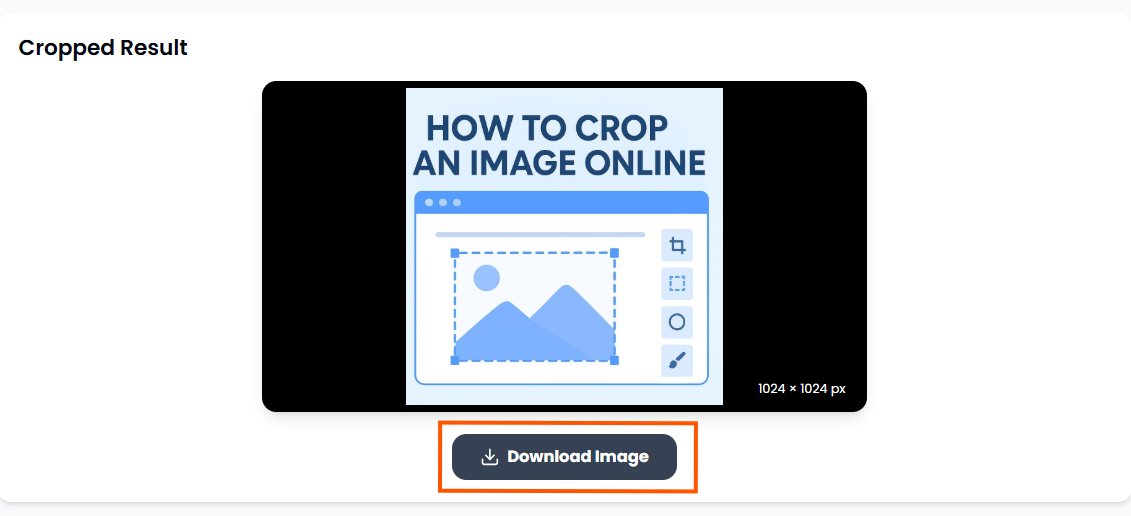
Pro Tip: Always keep your original uncropped image. If you later decide you want a different crop, starting from the original high-quality source produces better results than re-cropping an already-cropped image. If you need to rotate before cropping, use the rotate tool to straighten horizons first.
What Does Cropping an Image Mean?
Let's start with the basics. Cropping an image means removing unwanted portions from the edges of a photo to improve composition, focus attention, or fit specific dimensions. Think of it as reframing your photograph — deciding what stays in the picture and what gets cut out.
Unlike resizing, which changes the overall dimensions of an entire image, cropping selectively removes sections while keeping the remaining portion at its original quality and resolution. This is crucial — when you crop, you're not compressing or degrading the image; you're simply keeping less of it.
The Difference Between Cropping and Other Edits
Cropping vs. Resizing: Resizing changes the entire image's dimensions, making everything bigger or smaller. Cropping removes outer portions while keeping the remaining area at original quality.
Cropping vs. Trimming: These terms are often used interchangeably, but trimming typically refers to removing small edges, while cropping can involve more substantial reframing.
Cropping vs. Cutting: Cutting usually means removing internal sections, creating transparency. Cropping only removes from the edges inward.
Real-World Before and After Examples
Imagine a landscape photo taken during a road trip. The original shows beautiful mountains and sky, but also includes part of your car's hood in the bottom third — distracting and unprofessional. Crop away that bottom section, and suddenly you have a stunning, publishable landscape shot.
Or consider a portrait where the subject is positioned too far to one side with excessive empty space. Cropping to reposition the subject using the rule of thirds creates immediate visual improvement, making the photo feel balanced and intentional.
A group photo where someone's unwanted photobomb ruins the moment? Crop them out, and the photo becomes usable again.
These transformations take seconds with the right tool but make the difference between mediocre images and ones worth sharing.
Why You Need to Crop Images
Understanding when and why to crop helps you use this tool more effectively. Here are the most common reasons people crop images:
Improving Composition
Good composition makes photos visually appealing. The rule of thirds suggests placing subjects off-center at intersection points of imaginary grid lines. Cropping lets you reposition subjects to follow compositional principles, even if the original framing was off.
Removing Distractions
Backgrounds are full of potential distractions — other people, objects, clutter, or simply too much empty space. Cropping eliminates these elements, directing viewer attention exactly where you want it.
Meeting Platform Requirements
Social media platforms, websites, and print media all have specific dimension requirements. Instagram posts need square or 4:5 aspect ratios, YouTube thumbnails require 16:9, profile pictures are often circular crops of square images. Cropping ensures your images fit these specifications perfectly.
Focusing on Details
Sometimes the interesting part of an image occupies only a small portion of the frame. Cropping in on details — like a flower in a garden photo or a face in a crowd shot — creates more impactful images.
Correcting Framing Mistakes
We've all taken photos where the horizon isn't level, the subject is too far away, or the framing just feels off. Cropping fixes these issues without needing to retake the photo.
Creating Multiple Versions
One original photo can be cropped multiple ways for different uses — a wide banner crop for your website header, a square crop for Instagram, a vertical crop for Pinterest, all from the same source image.
Best Free Tools to Crop Images Online
The internet offers dozens of image cropping tools, but quality varies dramatically. Here are the best free options available in 2025:
ImageToolo Crop Tool (Recommended)
ImageToolo's crop tool stands out for its simplicity and power. It loads instantly, requires no account creation, handles all common image formats, and produces professional results without watermarks. The interface is intuitive enough for beginners yet powerful enough for professionals.
Best for: Everyone — from first-time users to experienced designers who want quick, quality results.
Canva
Canva is popular for overall design work and includes decent cropping functionality. However, it requires account creation and pushes premium features constantly, which can be distracting when you just want to crop one image quickly.
Best for: Users already working within Canva on broader design projects.
Pixlr
Pixlr offers a more Photoshop-like experience with advanced features. The interface is more complex, which provides power but comes with a steeper learning curve than simpler alternatives.
Best for: Users comfortable with traditional image editing software who need advanced features beyond basic cropping.
Photopea
This browser-based Photoshop clone offers professional-grade tools completely free. The cropping functionality is excellent, though the overall interface can be overwhelming for users who just need to crop one image.
Best for: Designers and photographers who need Photoshop-level capabilities without the subscription cost.
For most users, ImageToolo's dedicated crop tool offers the best balance of simplicity, speed, and quality — which is why we'll use it for our step-by-step guide. You can combine crop with resize, rotate, convert, and compress in one workflow using the other ImageToolo tools.
Tips for Perfect Cropping
Anyone can crop an image, but these professional techniques will elevate your results from acceptable to exceptional:
Follow the Rule of Thirds
Imagine dividing your image into a 3x3 grid with two horizontal and two vertical lines. Position important subjects at the intersection points of these lines rather than dead center. This creates more dynamic, visually interesting compositions.
Keep Your Subject Centered (When Appropriate)
While the rule of thirds is excellent guidance, centered compositions work beautifully for symmetrical subjects, portraits, or when you want to create formal, balanced images. Don't follow rules blindly — let the image guide you.
Maintain Aspect Ratio for Specific Uses
If you're cropping for a specific platform or purpose, use the correct aspect ratio from the start. This prevents awkward stretching or additional cropping when you upload your image.
Don't Crop Too Tight
Leave breathing room around subjects. Cropping right up to the edges of a person's head or body creates claustrophobic, uncomfortable compositions. A little negative space makes images feel more natural.
Watch the Edges
Check all four edges of your crop carefully. It's easy to accidentally cut off fingers, feet, or other important details when you're focused on the center of the image.
Consider the Background
When cropping, you're not just selecting your subject — you're also selecting background. Ensure the background elements within your crop complement rather than distract from your subject.
Crop to Remove Problems
Use cropping to eliminate issues like tilted horizons, distracting objects, or poor lighting on edges. It's an easy fix for common photographic problems.
Think About Final Use
An image destined for a website banner needs a different crop than one heading to Instagram. Crop with your final destination in mind to ensure the composition works in context.
Use Crop for Storytelling
Different crops tell different stories. A wide crop including environment provides context, while a tight crop on a face conveys emotion. Choose your crop based on what story you want to tell.
When Not to Crop Too Much
While cropping is powerful, it's possible to go too far. Here's when to exercise restraint:
Resolution Concerns
Every crop reduces the total number of pixels in your image. If you crop a 4000x3000 pixel image down to 800x600, you've discarded 95% of your pixels. If you later need a larger version, you're stuck with that small size. Always consider whether you might need higher resolution later.
Over-Cropping Reduces Quality
Aggressively cropping then enlarging the result creates pixelated, low-quality images. If you need to crop significantly, ensure your source image has enough resolution to maintain quality at the final size.
Losing Context
Sometimes the environment around your subject provides important context. A portrait of a chef becomes more meaningful with their kitchen in the background. Don't crop away context that adds value to your story.
Distorting Intent
Cropping can change the meaning of an image. Photojournalists and documentary photographers follow strict ethical guidelines about cropping because removing context can mislead viewers. Always crop honestly.
Platform Limitations
Some platforms automatically crop uploaded images. Instagram, for example, might crop your carefully composed image when it appears in feeds. Anticipate these automatic crops and compose accordingly.
Print Considerations
If you're preparing images for printing, remember that physical prints often include white borders or margins. Don't crop so tightly that important elements end up in these border areas.
Common Cropping Mistakes to Avoid
Learn from common errors so you don't repeat them:
Cropping Without Saving the Original
Always keep your original uncropped file. You can't un-crop an image, so permanent cropping of your only copy eliminates future options.
Cutting Off Important Elements
Check every edge carefully before finalizing. Accidentally cropping off hands, feet, or parts of faces creates awkward results.
Ignoring Aspect Ratios
Randomly cropping without considering aspect ratio often means re-cropping later when the image doesn't fit where you need it.
Cropping After Resizing
This workflow reduces quality. Always crop first to remove unwanted areas, then resize to your final dimensions. Need help with resizing? Our image tools collection includes everything you need to edit your images professionally.
Over-Cropping Low-Resolution Images
If you start with a 800x600 image and crop to 200x150, you have almost nothing left to work with. Ensure source images have adequate resolution before aggressive cropping.
Forgetting the Rule of Thirds
Centered subjects work sometimes, but defaulting to center placement for everything creates boring compositions. Experiment with off-center positioning.
Advanced Cropping Techniques
Once you've mastered basic cropping, these advanced techniques unlock even more possibilities:
Content-Aware Cropping
Some tools analyze your image content and suggest optimal crops automatically, identifying faces and important elements. While not perfect, these suggestions can inspire crops you hadn't considered.
Multiple Crops from One Image
Create a wide landscape crop for website headers, a square crop for Instagram, and a vertical crop for Pinterest — all from the same source image. This maximizes the value of each photo.
Rotating While Cropping
If your horizon is tilted, rotate the image slightly, then crop to remove the empty corners created by rotation. This straightens images beautifully.
Perspective Correction
Advanced tools let you correct perspective distortion while cropping. Photos of buildings that appear to lean backward can be straightened for more professional results.
Cropping for Different Devices
Create device-specific crops — one for desktop viewing, one optimized for mobile. This ensures optimal presentation regardless of how people view your content.
Final Thoughts
Cropping is the simplest yet most transformative tool in image editing. With just a few seconds of work, you can turn mediocre photos into compelling images, remove distractions, improve composition, and ensure your visuals fit perfectly wherever you need them.
The key is using the right tool and following best practices. ImageToolo's free crop tool makes the technical aspects effortless, letting you focus on the creative decisions that actually matter. No account required, no watermarks, no compromises — just fast, professional cropping that works exactly as you need it to.
Remember the essential principles: Consider composition carefully, maintain appropriate aspect ratios, don't crop too tightly, and always keep your originals. Follow these guidelines and you'll consistently create beautifully cropped images.
Ready to start cropping? Visit ImageToolo Crop Tool and experience the easiest way to crop images online. Whether you're preparing images for social media, optimizing photos for your website, creating perfect prints, or simply making your personal photos look better, ImageToolo gives you professional results in seconds. After cropping, you might want to compress your images for better performance, convert them to different formats, or even add a watermark to protect your work.
For more image editing tips, check out our guides on compressing images, converting formats, and choosing the right image format.
Stop settling for poorly framed images. Take control of your visual content with precise, thoughtful cropping, and watch your images transform from ordinary to extraordinary.
Your perfectly framed photo is just one crop away.